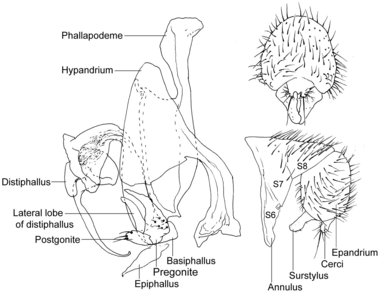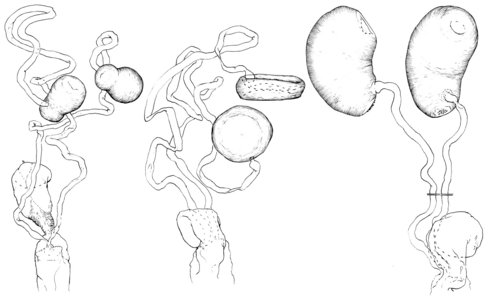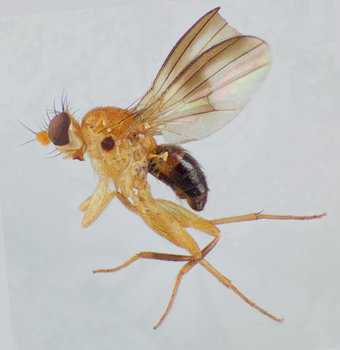Tetrameringia
Owen Lonsdale and Steve Marshall- Tetrameringia pubescens McAlpine
- Tetrameringia ustulata McAlpine
- Tetrameringia aethiopica Stuckenberg
- Tetrameringia distoma (Verbeke)
- Tetrameringia borealis Sueyoshi
- Tetrameringia stuckenbergi Barraclough
Introduction
Tetrameringia McAlpine, 1960 is a pale clusiine genus known from six species in Australia (T. pubescens McAlpine and T. ustulata McAlpine), Japan (T. borealis Sueyoshi), Africa (T. aethiopica Stuckenberg and T. stuckenbergi Barraclough) and Madagascar (T. distoma (Verbeke)). Barraclough (2002) estimates that at least ten species occur in Madagascar and about 30 occur throughout forested areas of the Afrotropical Region. Species are often collected around creeks and small streams in shady areas (McAlpine 1960).
Characteristics
As indicated by the generic name, Tetrameringia is defined by four pairs of fronto-orbital bristles, although some aberrant specimens of T. ustulata have only three pairs. The female abdomen is somewhat bulbous basally (or before its midpoint) and strongly narrowed distally, there are two dorsocentral bristles, no dorsal preapical tibial bristles, the bristles are black, and there is no subnotal stripe.
Like other Clusiinae, Tetrameringia can also be characterized by an inclinate anterior fronto-orbital bristle, a small ratio of the length of the ultimate section of vein M to the penultimate, a presutural intra-alar bristle, outstanding bristles on the posterodorsal surface of the fore femur, a jointed distiphallus (entire and bent in some genera), and a posteromedial truncated notch on the vertex (Lonsdale & Marshall 2006).


Male genitalia of Tetrameringia ustulata. © Owen Lonsdale
Phylogenetics
Phylloclusia is considered the sister-group to the Tetrameringia in the Clusiinae on the basis of male and female genitalic synapomorphies: posterior margin of male sternite 6 setose; surstylus small, thin and subtriangular; inner surface of surstylus without basal projection; distiphallus broken medially and reflexed; ventral shield of phallapodeme raised from shaft (almost entirely reversed in P. quadrivittata); spermatheca pigmented, irregularly-shaped and with minute transverse grooves (smooth and spherical in T. borealis Sueyoshi); spermathecal duct with subbasal attachment to spermatheca (Lonsdale & Marshall, 2006b). Loss of the hypandrial bristles may be an additional synapomorphy of these genera, but they are also absent in Clusia.
Externally, both genera differ from other Clusiidae by having inclinate anterior fronto-orbital bristles, two pairs of dorsocentral bristles, a well-developed postvertical bristle, one pair of vibrissae, a small M1,2 ratio (1.9-2.5), bristles on the posterodorsal surface of the fore femur and no interfrontal or dorsal preapical tibial bristles. Most species in these genera also usually lack a subnotal stripe and have an irregular row of ventral ctenidial bristles on the male fore and mid femora (Lonsdale & Marshall, 2006b).


Female internal genitalia: Tetrameringia pubescens McAlpine; T. ustulata McAlpine; Phylloclusia darlingi Lonsdale&Marshall. © Owen Lonsdale.
References
Barraclough, D.A. 2002. A new species of Tetrameringia McAlpine (Diptera: Schizophora: Clusiidae) from Malawi, the third species from the Afrotropical Region. African Invertebrates, 43: 5-10.
Lonsdale, O. & Marshall, S.A. 2006. Redefinition of the Clusiinae and Clusiodinae, description of the new subfamily Sobarocephalinae, revision of the genus Chaetoclusia and a description of Procerosoma gen. n. (Diptera: Clusiidae). European Journal of Entomology, 103: 163-182.
Lonsdale, O. & Marshall, S.A. 2006b. Revision of the genus Phylloclusia (Diptera: Clusiidae: Clusiinae). The Canadian Entomologist (accepted for publication).
McAlpine, D.K. 1960. A review of the Australian species of Clusiidae (Diptera: Acalyptrata). Rec. Aust. Mus. 25: 63-94.
Title Illustrations

| Scientific Name | Tetrameringia ustulata McAlpine |
|---|---|
| Specimen Condition | Dead Specimen |
| Sex | Male |
| Life Cycle Stage | Adult |
| Copyright |
© Steve Marshall

|
About This Page
Owen Lonsdale

Canadian National Collection of Insects, Arachnids & Nematodes
Steve Marshall

University of Guelph, Canada
Correspondence regarding this page should be directed to Owen Lonsdale at and Steve Marshall at
Page copyright © 2011 Owen Lonsdale and Steve Marshall
 Page: Tree of Life
Tetrameringia.
Authored by
Owen Lonsdale and Steve Marshall.
The TEXT of this page is licensed under the
Creative Commons Attribution-NonCommercial License - Version 3.0. Note that images and other media
featured on this page are each governed by their own license, and they may or may not be available
for reuse. Click on an image or a media link to access the media data window, which provides the
relevant licensing information. For the general terms and conditions of ToL material reuse and
redistribution, please see the Tree of Life Copyright
Policies.
Page: Tree of Life
Tetrameringia.
Authored by
Owen Lonsdale and Steve Marshall.
The TEXT of this page is licensed under the
Creative Commons Attribution-NonCommercial License - Version 3.0. Note that images and other media
featured on this page are each governed by their own license, and they may or may not be available
for reuse. Click on an image or a media link to access the media data window, which provides the
relevant licensing information. For the general terms and conditions of ToL material reuse and
redistribution, please see the Tree of Life Copyright
Policies.
- First online 25 August 2005
- Content changed 20 August 2007
Citing this page:
Lonsdale, Owen and Steve Marshall. 2007. Tetrameringia. Version 20 August 2007 (under construction). http://tolweb.org/Tetrameringia/27672/2007.08.20 in The Tree of Life Web Project, http://tolweb.org/








 Go to quick links
Go to quick search
Go to navigation for this section of the ToL site
Go to detailed links for the ToL site
Go to quick links
Go to quick search
Go to navigation for this section of the ToL site
Go to detailed links for the ToL site